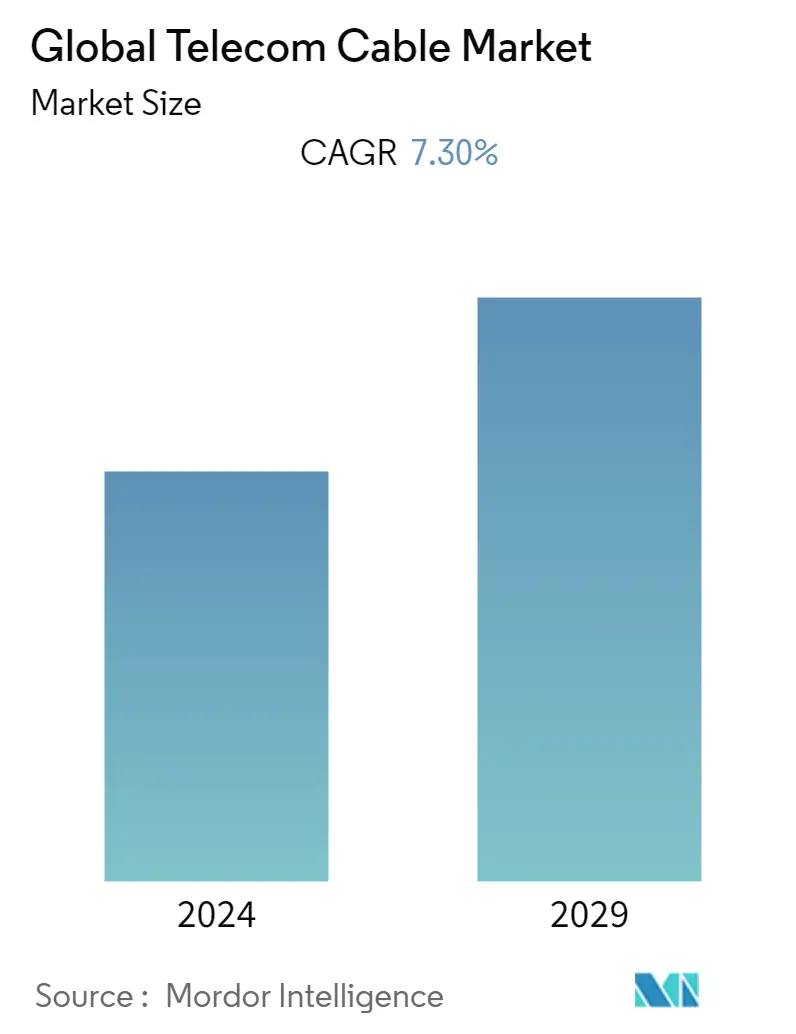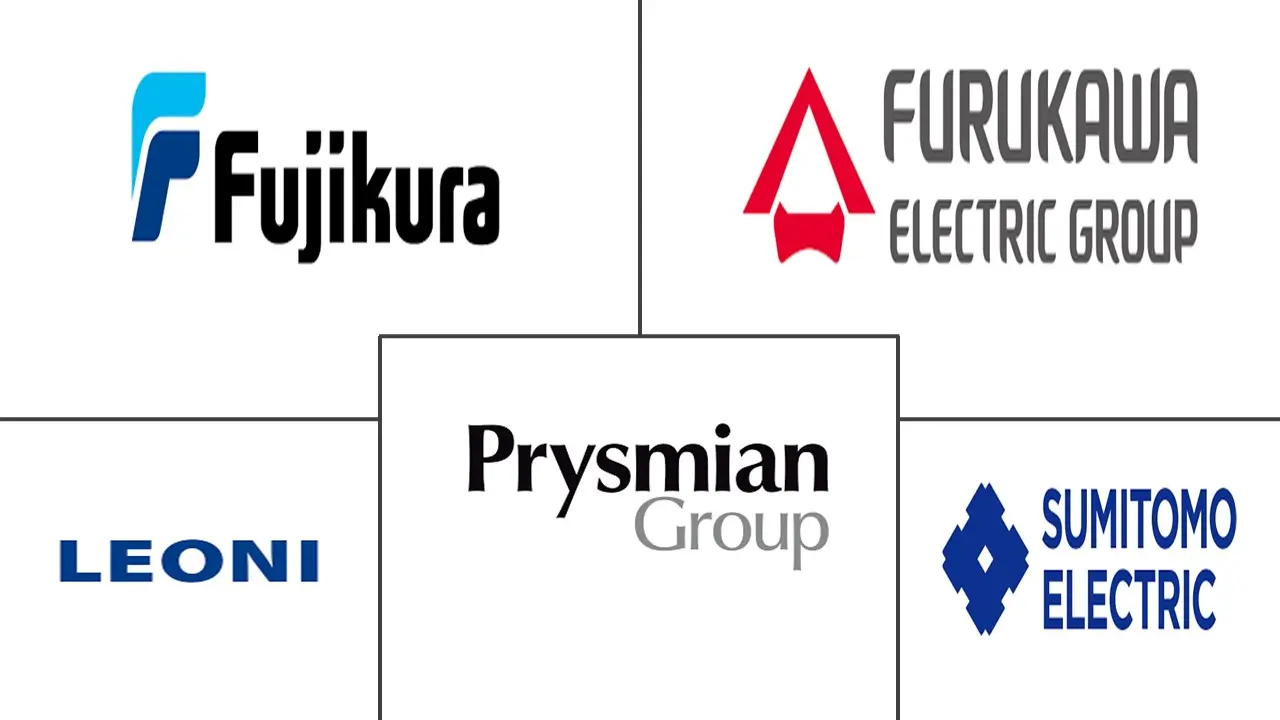Market Size of Global Telecom Cable Industry

| Study Period | 2019 - 2029 |
| Base Year For Estimation | 2023 |
| CAGR | 7.30 % |
| Fastest Growing Market | Asia-Pacific |
| Largest Market | Asia-Pacific |
| Market Concentration | High |
Major Players
*Disclaimer: Major Players sorted in no particular order |
Telecom Cable Market Analysis
Increasing smartphone adoption and global penetration of the internet are some of the key factors influencing the growth of the telecom cable market, which is indirectly involved in the growth of the telecom cable market. The global telecom cable market is expected to register a CAGR of 7.3% over the forecast period from 2022 to 2027.
- Internet-enabled devices such as smartphones and tablets have become indispensable tools for communication, information, and entertainment worldwide. The increasing adoption of smartphones and the widespread use of the internet worldwide is a key factors influencing the growth of the telecommunications equipment market, which is responsible for developing the telecommunications cable market.
- IoT technology uses telecom services for asset management and remote system monitoring. By using an IoT platform like Kaa, telecom companies can connect their diverse physical assets to the cloud and remotely manage their operations, investigate malfunctions, run firmware upgrades, and keep track of inventory, leading to market growth.
- Recently, the shift to more decentralized government funding for broadband infrastructure has been observed. For instance, in November 2021, the USD 1 trillion Infrastructure Investment and Employment Act (IIJA) was passed in the United States, which allocates USD 65 billion for broadband access, clean water, electric grid renewal, transportation, and road proposals. Government programs dedicated to expanding and improving telecommunications infrastructure and services are expected to boost the market's growth.
- The increased operating and maintenance cost of telecom cables is one of the major factors likely to hamper the market growth. Moreover, underground fiber provides more reliability and requires fewer maintenance efforts. Hence, there is a huge opportunity for optical fiber cables in the market in the current and future.
- The outbreak of Covid-19 and the pandemic has become a huge challenge to continue operating and providing support even with agents working from home, as the telecom industry heavily relies on huge contact centers to assist their customers. However, due to the increased work-from-home trend, there is high demand for internet connectivity, positively boosting the market's growth.
Telecom Cable Industry Segmentation
The telecom cables enable two-way communication over long distances by transferring information from one spot to another. However, cables in telecommunications fields are used to transmit electromagnetic waves. They are called electromagnetic waveguides. Moreover, the telecom cable market applications studied are broad and consider telephony and video conferencing, facsimile, broadcast and interactive television, instant messaging, e-mail, distributed collaboration, a host of Web- and Internet-based communication, and data transmission. The study also provides the impact of COVID-19 on the market and trends of the global key players.
| By Type | |
| Coaxial Cable | |
| Fiber Optic | |
| Data Center Cables | |
| Mobile Networks | |
| Twisted Pair Cable | |
| LAN Cables |
| By Application | |
| Telecommunication applications | |
| Data Centers | |
| CATV | |
| Computer Network | |
| Others |
| Geography | ||||||
| ||||||
| ||||||
| ||||||
| Rest of the World |
Global Telecom Cable Market Size Summary
The telecom cable market is experiencing significant growth, driven by the increasing adoption of smartphones and the global penetration of the internet. This growth is further fueled by the rise of IoT technologies, which utilize telecom services for asset management and remote monitoring. Government initiatives, such as the Infrastructure Investment and Employment Act in the United States, are also contributing to market expansion by funding broadband infrastructure improvements. Despite challenges like high operating and maintenance costs, the market is poised for growth, particularly with the increasing demand for optical fiber cables, which offer greater reliability and require less maintenance. The COVID-19 pandemic has also played a role in boosting demand for telecom cables, as the work-from-home trend has heightened the need for robust internet connectivity.
The market is characterized by intense competition among key players such as Sumitomo Electric Industries, Leoni, and Nexans, who are actively innovating and expanding their cable businesses to meet the growing demand for high-speed internet. The introduction of 4G LTE and 5G services, along with advancements in multi-access edge computing and private mobile networks, are further propelling market growth. The Asia-Pacific region, in particular, is witnessing substantial growth due to increasing demand for high-speed connectivity and significant investments in IT infrastructure. Strategic partnerships, mergers, and acquisitions among major players are strengthening their market positions, ensuring continued expansion and innovation in the telecom cable industry.
Global Telecom Cable Market Size - Table of Contents
-
1. MARKET INSIGHTS
-
1.1 Market Overview
-
1.2 Porter's Five Forces Analysis
-
1.2.1 Threat of New Entrants
-
1.2.2 Bargaining Power of Buyers/Consumers
-
1.2.3 Bargaining Power of Suppliers
-
1.2.4 Threat of Substitute Products
-
1.2.5 Intensity of Competitive Rivalry
-
-
1.3 Value Chain/Supply Chain Analysis
-
1.4 Assessment of the Impact of COVID -19 on the Market
-
-
2. MARKET SEGMENTATION
-
2.1 By Type
-
2.1.1 Coaxial Cable
-
2.1.2 Fiber Optic
-
2.1.3 Data Center Cables
-
2.1.4 Mobile Networks
-
2.1.5 Twisted Pair Cable
-
2.1.6 LAN Cables
-
-
2.2 By Application
-
2.2.1 Telecommunication applications
-
2.2.2 Data Centers
-
2.2.3 CATV
-
2.2.4 Computer Network
-
2.2.5 Others
-
-
2.3 Geography
-
2.3.1 North America
-
2.3.1.1 United States
-
2.3.1.2 Canada
-
2.3.1.3 Mexico
-
-
2.3.2 Europe
-
2.3.2.1 Germany
-
2.3.2.2 France
-
2.3.2.3 Uk
-
2.3.2.4 Rest of Europe
-
-
2.3.3 Asia-Pacific
-
2.3.3.1 Japan
-
2.3.3.2 China
-
2.3.3.3 India
-
2.3.3.4 Rest of Asia-Pacific
-
-
2.3.4 Rest of the World
-
-
Global Telecom Cable Market Size FAQs
What is the current Global Telecom Cable Market size?
The Global Telecom Cable Market is projected to register a CAGR of 7.30% during the forecast period (2024-2029)
Who are the key players in Global Telecom Cable Market?
Sumitomo Electric Industries, Ltd., Prysmian Group, Fujikura, Furukawa Electric Co. Ltd and Leoni are the major companies operating in the Global Telecom Cable Market.

